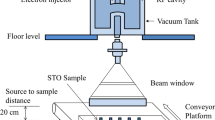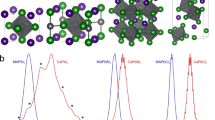Abstract
Local electronic structure was investigated by observing hyperfine interactions (HFI) in Calcium titanate (CTO) perovskite using time differential perturbed angular correlation (TDPAC) spectroscopy. CTO was synthesized by gel-combustion method and doped with (181Hf/181Ta) TDPAC probe to study chemical environment around probe atom. Study revealed presence of two sites characterized by different quadrupole interaction frequencies, ω1a = 203 (2) and ω1b = 160 (2) Mrad/s, but with similar asymmetry parameters, ηa = 0.47 (0.01) and ηb = 0.47 (0.03). Electric Field Gradient (EFG) calculated from HFI parameters are 3.12 (0.03) and 2.47 (0.03) × 1021 V/m2 for the two sites. Point charge model calculation concluded that the two sites have different EFG and corroborated the variation in EFG between two sites accurately. Plausible reasons for existence of two different HFIs at B-site of CTO perovskite is discussed.





Similar content being viewed by others
References
Bhalla AS, Guo R, Roy R (2000) The perovskite structure—a review of its role in ceramic science and technology. Mater Res Innov 4:3–26. https://doi.org/10.1007/s100190000062
Hanajiri Y, Yokoi H, Matsui T et al (1997) Phase equilibria of CaTi03 doped with Ce, Nd and U. J Nucl Mater 247:285–288. https://doi.org/10.1016/S0022-3115(97)00055-X
Bhadala F, Suthar L, Roy M, Jha VK (2018) Dielectric and transport properties of CaTiO3. In: AIP Conference Proceedings. p 050028
Kell RC, Greenham AC, Olds GCE (1973) High-permittivity temperature-stable ceramic dielectrics with low microwave loss. J Am Ceram Soc 56:352–354. https://doi.org/10.1111/j.1151-2916.1973.tb12684.x
Tamayo R, Espinoza-González R, Gracia F et al (2019) As(III) removal from aqueous solution by calcium titanate nanoparticles prepared by the sol gel method. Nanomaterials 9(5):733. https://doi.org/10.3390/nano9050733
Passi M, Pal B (2021) A review on CaTiO3 photocatalyst: activity enhancement methods and photocatalytic applications. Powder Technol 388:274–304. https://doi.org/10.1016/j.powtec.2021.04.056
Yahya NY, Ngadi N, Jusoh M, Halim NAA (2016) Characterization and parametric study of mesoporous calcium titanate catalyst for transesterification of waste cooking oil into biodiesel. Energy Convers Manag 129:275–283. https://doi.org/10.1016/j.enconman.2016.10.037
Xie W, Hu W, Zou L et al (2015) Tuning bipolar resistive switching by forming defect dipoles in A-site-deficient perovskite calcium titanate thin films. Appl Phys Express 8:045504. https://doi.org/10.7567/APEX.8.045504
Krause A, Weber W, Jahn A et al (2011) Evaluation of the electrical and physical properties of thin calcium titanate high-k insulators for capacitor applications. J Vac Sci Technol B, Nanotechnol Microelectron Mater Process Meas Phenom 29:01AC07. https://doi.org/10.1116/1.3521507
Zacate M, Jaeger H (2011) Perturbed angular correlation spectroscopy—a tool for the study of defects and diffusion at the atomic scale. Defect Diffus Forum 311:3–38. https://doi.org/10.4028/www.scientific.net/DDF.311.3
Schell J, Kamba S, Kachlik M et al (2019) Thermal annealing effects in polycrystalline EuTiO 3 and Eu 2 Ti 2 O 7. AIP Adv 9:125125. https://doi.org/10.1063/1.5115466
López-García A, Alonso RE, Falabella M, Echeverria G (2010) The effect of oxygen vacancies in Ca1-xSrxHfO 3. Ferroelectrics 396:37–48. https://doi.org/10.1080/00150191003795130
De La Presa P, López-García A (1997) Defects in CaHfO3 produced by thermal neutron irradiation. Radiat Eff Defects Solids 140:141–149. https://doi.org/10.1080/10420159708216841
Schell J, Marschick G (2019) TDPAC studies of local defects and phenomena in ferroics and multiferroics. Crystals 9:611. https://doi.org/10.3390/cryst9120611
Kumar A, Mishra RK, Khader SA et al (2021) Electron beam irradiation induced changes in local structure of simulated waste bearing sodium borosilicate glasses. Nucl Instruments Methods Phys Res Sect B Beam Interact with Mater Atoms 486:85–93. https://doi.org/10.1016/j.nimb.2020.11.007
Kumar A, Mishra RK, Bhardwaj YK et al (2021) Probing electronic environment in gamma irradiated sodium borosilicate glass and simulated waste glass: a perturbed angular correlation spectroscopy study. J Radioanal Nucl Chem 328:569–576. https://doi.org/10.1007/s10967-021-07686-z
Kumar A, Sahu M, Deb AC et al (2021) Structural investigation in strontium titanate (SrTiO3) synthesized by gel-combustion method and in-gelation method: a TDPAC and XRD study. J Mater Sci Mater Electron 32:11577–11587. https://doi.org/10.1007/s10854-021-05753-5
Rodriguez-Carvajal J (2000) FULLPROF: a program for Rietveld refinement and pattern matching analysis. In satellite meeting on powder diffraction of the XV congress of the IUCr. Lab Leon Brillouin Gif sur Yv
Kumar A, Mandal G, Das P, Tomar BS (2017) Hyperfine interaction study of pressure induced phase transformations in Hafnia. J Radioanal Nucl Chem 313:683–687. https://doi.org/10.1007/s10967-017-5351-6
Chatterjee A, Ramachandran K, Kumar A, Behere A (2013) Linux advanced multiparameter system. Nucl Phys Div BARC http//www.tifr.res.in/~ pell/lamps.html
Lindgren B (1996) Depack software. Hyperfine Interact C:613
Spearing DR (1994) ptchg: A FORTRAN program for point-charge calculations of electric field gradients (EFGs). Comput Geosci 20:615–624. https://doi.org/10.1016/0098-3004(94)90083-3
Okhotnikov K, Charpentier T, Cadars S (2016) Supercell program: a combinatorial structure-generation approach for the local-level modeling of atomic substitutions and partial occupancies in crystals. J Cheminform 8:17. https://doi.org/10.1186/s13321-016-0129-3
Sebastian KC, Somayajulu DRS, Jaffrey SNA et al (1996) Quadrupole interaction at 181Ta in BaHfO3. Hyperfine Interact 99:347–351. https://doi.org/10.1007/BF02274939
López Garciá AR, de la Presa P, Rodríguez AM (1991) Temperature dependence of the hyperfine interaction in the cubic phase of BaHfO 3. Phys Rev B 44:9708–9710. https://doi.org/10.1103/PhysRevB.44.9708
Lopez-Garcia A, de la Presa P, Rodriguez AM et al (1993) Radiation damage produced in BaHfO3 irradiated with thermal and fast neutrons. Phys Rev B 47:84–87. https://doi.org/10.1103/PhysRevB.47.84
De La Presa P, García AL (1998) PAC investigation on AHfO3 with a = Ca, Sr and Ba. J Korean Phys Soc 32:1–3
da Andrade PR, Forker M, Rogers JD, Kunzler JV (1972) Nuclear-quadrupole interactions in perovskite-type compounds of Hf 181 studied by the perturbed-angular-correlation technique. Phys Rev B 6:2560–2565. https://doi.org/10.1103/PhysRevB.6.2560
da Silva RA, Saxena RN, Carbonari AW, Cabrera-Pasca GA (2010) Investigation of hyperfine interactions in GdCrO3 perovskite oxide using PAC spectroscopy. Hyperfine Interact 197:53–58. https://doi.org/10.1007/s10751-010-0182-7
López-García A, Alonso R, de La Presa P, Ayala A (1999) Hyperfine interactions in cubic perovskites. Hyperfine Interact 120:97–106. https://doi.org/10.1023/A:1017078012946
Olzon-Dionysio M, Souza SD, Ayala AP et al (2001) Concentration dependence of the electric field gradient in PbZr1−xTixO3 ceramics. Hyperfine Interact 136/137:523–528. https://doi.org/10.1023/A:1020570707357
Alonso RE, García AL, Ayala A, Presa P de la (1998) Temperature dependence of the nuclear quadrupole interaction at Zr-Ti sites in in the Zr-rich rhombohedral and cubic phases. J Phys Condens Matter 10:2139–2153. https://doi.org/10.1088/0953-8984/10/9/017
Uhrmacher M, Krishnamurthy VV, Lieb K-P et al (1998) Perturbed angular correlation studies of electric field gradients at 111 Cd in the perovskites PbZrO3 and BaTiO3. Zeitschrift für Phys Chemie 206:249–264. https://doi.org/10.1524/zpch.1998.206.Part_1_2.249
Schafer G, Herzog P, Wolbeck B (1972) Static electric quadrupole interaction of Ta- and Hf-ions in barium and lead titanate. Zeitschrift fur Phys 257:336–352. https://doi.org/10.1007/BF01392991
Sternheimer RM (1986) Shielding and antishielding of nuclear quadrupole moments. Zeitschrift fur Naturforsch - Sect A J Phys Sci 41:24–36. https://doi.org/10.1515/zna-1986-1-207
Gupta RP, Sen SK (1973) Sternheimer shielding-antishielding; rare-earth Ions. Phys Rev A 7:850–858. https://doi.org/10.1103/PhysRevA.7.850
Gupta RP, Sen SK (1973) Sternheimer shielding-antishielding. II. Phys Rev A 8:1169–1172. https://doi.org/10.1103/PhysRevA.8.1169
Sen KD, Narasimhan PT (1978) Nuclear hexadecapole antishielding factors: tripositive lanthanide and tetrapositive actinide ions. Phys Rev A 18:2450–2452. https://doi.org/10.1103/PhysRevA.18.2450
Sen KD, Weiss A, Schmidt PC (1986) Electric-field-gradient sternheimer function for closed shell ions. Hyperfine Interact 30:253–264. https://doi.org/10.1007/BF02396918
Burns G, Wikner EG (1961) Antishielding and contracted wave functions. Phys Rev 121:155–158. https://doi.org/10.1103/PhysRev.121.155
Sen KD, Narasimhan PT (1977) Sternheimer antishielding factors for core electrons in metals: comparison with free-ion results. Phys Rev A 16:1786–1788. https://doi.org/10.1103/PhysRevA.16.1786
Attili R, Saxena R, Carbonari A et al (1998) Delafossite oxides studied by perturbed-angular-correlation spectroscopy using a probe. Phys Rev B - Condens Matter Mater Phys 58:2563–2569. https://doi.org/10.1103/PhysRevB.58.2563
Dogra R, Junqueira AC, Saxena RN et al (2001) Hyperfine interaction measurements in (formula presented) and (formula presented) perovskites using perturbed angular correlation spectroscopy. Phys Rev B - Condens Matter Mater Phys 63:1–9. https://doi.org/10.1103/PhysRevB.63.224104
Beri AC, Lee T, Das TP, Sternheimer RM (1983) First-principles theory of antishielding effects in the nuclear quadrupole interaction in ionic crystals: application to Fe-57m in Fe2O3. Phys Rev B 28:2335–2351. https://doi.org/10.1103/PhysRevB.28.2335
Acknowledgements
Authors thank Dr Rahul Tripathi (Head, Nuclear Chemistry Section, Radiochemistry Division) for his constant support during the work. Authors also thank Dr. Bal Govind Vats (SO/E, Fuel Chemistry Division) for XRD acquisition.
Funding
Not Applicable.
Author information
Authors and Affiliations
Contributions
AK: visualization, investigation, draft-writing and editing. MS: resources, investigation. BST: supervision, draft-proofing.
Corresponding author
Ethics declarations
Conflicts of interest
There are no conflicts to declare.
Additional information
Publisher's Note
Springer Nature remains neutral with regard to jurisdictional claims in published maps and institutional affiliations.
Rights and permissions
Springer Nature or its licensor (e.g. a society or other partner) holds exclusive rights to this article under a publishing agreement with the author(s) or other rightsholder(s); author self-archiving of the accepted manuscript version of this article is solely governed by the terms of such publishing agreement and applicable law.
About this article
Cite this article
Kumar, A., Sahu, M. & Tomar, B.S. Study of hyperfine interactions in calcium titanate perovskite using TDPAC spectroscopy. J Radioanal Nucl Chem (2024). https://doi.org/10.1007/s10967-024-09441-6
Received:
Accepted:
Published:
DOI: https://doi.org/10.1007/s10967-024-09441-6




